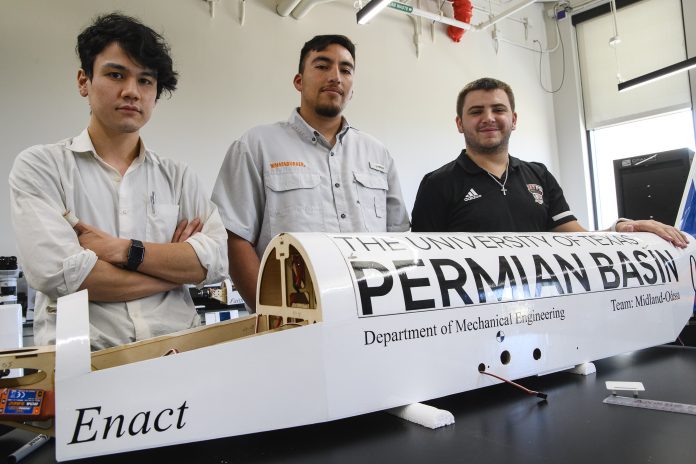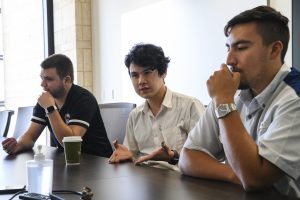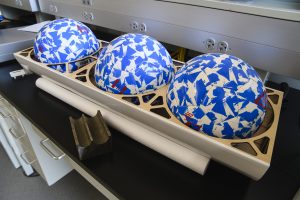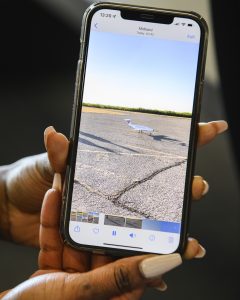
As their senior project, four University of Texas Permian Basin students decided to build a plane and enter the SAE Aero Design Competition in Fort Worth.
The contest starts Friday and goes through Saturday with awards on Sunday at Thunderbird Field.
Three of the four students have graduated. Ramiro Andujo earned a bachelor’s degree in mechanical engineering; Garrett Martin, a bachelor’s degree in mechanical engineering with a concentration in nuclear engineering; and Arashi Shimizu, a bachelor’s degree in mechanical engineering.

Sophomore Melany Azocar, a mechanical engineering sophomore, rounded out the group.
Bibian Ogbuji, assistant research professor, was their faculty leader and is going with them to Fort Worth.
The Fort Worth contest is the East Competition and Martin said there is a West Competition in California.
Andujo said the team spent the fall semester designing the plane and began construction in the spring.
Ogbuji said the UTPB team will probably be one of the smallest groups because places like Texas A&M University have classes on this.
There will be about 50 teams with participants from all over the world.
“… We have four students who pretty much put in a tremendous amount of time and effort, so I’m very, very impressed with them,” Ogbuji said.
The plane is 85 inches from the nose to the tail and has a 90.2 inch wing span. It is radio controlled.
Martin said the craft is made entirely out of balsa and birch wood.

“We also used 3D printed PLA plastics and the landing gear. The nose gear is aluminum and the main gear is carbon fiber because we’re allowed to do that in the competition. The spars are also aluminum,” Martin said.
He explained that the spars are what the wing puts all its weight on.
“The spars are basically the structure of the wing,” Martin said.
They have enough room in the fuselage to carry three soccer balls.
Andujo said UTPB no longer has an aerospace program, so all the information they learned was through self study.
Shimizu said one of the reasons they could design and build a plane is because aerospace engineering is an extension of mechanical engineering.
He said learning the aerospace part was challenging, but manageable.
Ogbuji said they had their first test flight Wednesday morning and they showed a video of it.
“It did better than we expected it to do,” Martin said.
They have two planes just in case, but they are only taking one. It had to have room for three soccer balls in the fuselage.
Martin and Andujo said they never thought they would be building a plane, but Shimizu had done it before.
Shimizu said it flew well, but it was a high school project.
“We were able to use math to determine that the plane would even fly before we ever got the wood to start building it. That math included fluid dynamics, aerodynamics, structural analysis, which is just basically hey we subject this to 10 pounds is it going to break, and no it will not,” Martin said.

For senior design, Andujo said, most students get in groups and design some sort of project.
“Either they’ll have something in mind, or they can speak with a professor. For example, in our senior design group there were two other groups. One group did basically a float gear for a pump jack … and the other group did a cargo trailer. The cargo trailer was basically their own idea and the float gear was Dr. (Forrest) Flocker’s idea,” Martin said.
Flocker, who is retiring, is an associate professor of mechanical engineering.
Shimizu said it looked like there were previous plans for the aerospace competition, but they just made the schematics, so that’s how they know about the competition.
With a test flight under their belt, Martin said they feel more confident about their design.
“There’s specific criteria with the competition. The … No. 1 thing is takeoff and landing distance. We have to take off within 100 feet. …We’re extremely confident we can do that with no issues and also to qualify to compete we have to be able to carry a soccer ball completely enclosed inside the … cargo bay … But we are carrying three soccer balls because one is going to be too easy,” Martin said.
“There’s a whole laundry list of rules and requirements, but we basically have to take off within 100 feet, do a big ole circle about 800 feet in diameter-ish and then come back and land,” he added.
Martin noted that there is also a contest requirement that teams have to submit a completely from-scratch plane every year.
“Ours is extremely from scratch. We have no prior template, so really, when it came to designing it we just leaned on a couple of books … and took a little bit of inspiration from a Cessna 172. But if you were to compare our planes, they look nothing like a Cessna 172,” Martin said.
Although the project was a lot of work on top of their school work, Martin said it was worth it.
“There were a lot of ups and downs and a lot of challenges with it as well. But … for as much as we’ve all complained about having the amount of work we’ve had to do, a lot of it has been really enjoyable,” Martin said.

Shimizu said Martin and Andujo did a really good job, even though aerospace is not their area.
Azocar said Shimizu got her into the plane project, gradually.
“I thought it would be fun. It was a really tough semester. This semester was full of work, but it was worth it. I feel like it came out good. I always want to learn things. I’m always up to that. Aerospace and airplane stuff is just new to me at this point,” Azocar said.
“I’m proud that we … are doing something to represent the College of Engineering, but for me it’s more like we’re doing something good for us to gain experience,” she added.
She noted that UTPB has supported their initiative to do this project.
Shimizu said UTPB is small and flexible enough to make the competition possible. He added that if you are motivated enough, have a good plan and present it to the right people, you can receive support.
Ogbuji is also looking forward to the competition.
“I literally had chills watching the flight today and knowing the process, being there and seeing all of their hard work. Last night, we were awake until 12:23 (a.m.). They were in the lab trying to fix some mechanical issues and electrical issues that we had and just being able to see all of that pay off is something that I am so glad to be part of,” Ogbuji said.
She added that the team was supported by Midland Development Corp., Air Compressor Solutions, Eastland Oil Company and the College of Engineering.



